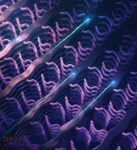(Press-News.org) Most of us are familiar with the fact that women live longer than men. But fellas, if we told you there was one thing that could be done to increase your lifespan, would you do it?
In a study published today in eLife , University of Otago researchers along with collaborators from the United States, have shown that castration of male sheep delays aging of DNA compared to intact males, and that it also drives feminine characteristics of DNA and the chemical tags it holds, known as DNA methylation.
"Both farmers and scientists have known for some time that castrated male sheep live on average much longer than their intact counterparts; however, this is the first time anyone has looked at DNA to see if it also ages slower," says first-author of the study, University of Otago Anatomy PhD student Victoria Sugrue.
In order to do this, the researchers first had to generate an 'epigenetic clock' from large numbers of sheep so they could measure DNA aging. They then looked at the epigenetic clock of castrated and intact males and found their 'ticking rate' is different; meaning that the longer lives of castrated sheep, or 'wethers' as they are referred to by farmers, is reflected in their DNA.
Underpinning this study is the rapid development of tools to study DNA aging. Recently it has become possible to estimate the age of humans and other mammals using only DNA and epigenetic clocks.
Inventor of the epigenetic clock and study co-author, Professor Steve Horvath, from the University of California in Los Angeles explains; "We developed a way to measure biological age in a broad range of mammals - we have looked at over 200 species so far and discovered surprising commonality in which animals age. But the sheep study was unique in that it specifically isolated the effects of male hormones on aging."
Dr Tim Hore, research team co-leader and Senior Lecturer at Otago's Department of Anatomy, says the study's findings provide new avenues to understand the mechanism of male-accelerated aging.
"We found that males and females have very different patterns of DNA aging in sheep; and that despite being male, the castrates (wethers) had very feminine characteristics at specific DNA sites.
"Interestingly, those sites most affected by castration also bind to receptors of male hormones in humans at a much greater rate than we would expect by chance. This provides a clear link between castration, male hormones and sex-specific differences in DNA aging," Dr Hore says.
To understand which tissues are strongly affected by hormone levels, the researchers looked at sex effects in mice. In tissues where the male hormone receptors are found (e.g. skin, kidney and brain) large differences between the DNA patterns in males and females was observed. In contrast, tissues without male hormone receptor expression looked the same in males and females.
"Most researchers use blood for measuring biological age, and we did this for sheep too; however, it was not blood but skin where we found sex-specific aging effects in the DNA of sheep. And this appeared to be also true for mouse where we had data from many tissues and in both males and females," Dr Hore adds.
In addition to stimulating further understanding about the role of male sex hormones in accelerating aging, the researchers hope their work will have wider implications. As the first epigenetic clock for sheep, it is possible this work will end up being used to help farmers determine which sheep are going to live longer (and be more productive), or identify meat claiming to be succulent New Zealand lamb, when it is really mutton.
This work was funded by University of Otago and the Paul G. Allen Frontiers Group. The funders had no role in study design, data collection and interpretation, or the decision to submit the work for publication. Research materials were provided by generous donation from the Central Otago farming community, Totovision Ltd, the University of Auckland and the South Australian Research and Development Institute.
SOMETHING TO PONDER: SHREK the famous NZ wether.
Arguably the most famous New Zealand sheep was "Shrek", the Central Otago merino who evaded musterers for 6 years and consequently grew a 27 kg fleece - many times larger than the average sheep. Shrek's discovery, and subsequent shearing, came with great media interest, national travel and even a visits to offshore icebergs and the New Zealand parliament.
It has long been speculated that the secret to Shrek's mammoth fleece and subsequent notoriety was his cunning ability to avoid capture and the fact he could survive cold alpine winters by sheltering in caves. But less appreciated is the fact that Shrek was a castrated male (wether), and ultimately lived to a grand age of 16.
"By the time Shrek was caught he was already 10 years old - roughly the maximum age of the most long-lived sheep on a commercial farm. I think at least part of Shrek's fame was simply that he lived so long - something which almost certainly wouldn't have happened if he was not castrated," Dr Hore says.
INFORMATION:
Three mutations in the Epsilon coronavirus spike protein dampen the neutralizing potency of antibodies induced by current vaccines or past COVID infections.
The mutations give this coronavirus variant of concern a means to totally evade specific monoclonal antibodies used in clinics and reduce the effectiveness of antibodies from the plasma of vaccinated people.
To better understand the exact immune escape strategies at work here, the scientists visualized this variant's infection machinery to see what is different from the original configuration of the pandemic coronavirus, and what the implications of these changes are.
The international project was led by David Veesler's lab in the Department of Biochemistry at the University of Washington ...
In a retrospective, multi-centre cohort study conducted by researchers from Nanjing University, Huazhong University of Science and Technology, Jinling Hospital and the Second Hospital of Nanjing, a microRNA-like small RNA encoded by SARS-CoV-2 was identified in the serum of COVID-19 patients, which can be developed as a non-invasive biomarker for stratification of severe patients from mild/moderate ones and for identification of high-risk individuals before clinical manifestation of severe symptoms. This biomarker ensures proper allocation of patients to different ...
A research team, led by Professor Dai-Sik Kim in the Department of Physics at UNIST has developed a new technique of predefining the crack pattern on a flexible substrate by a sequential deposition of metallic layers which leads to a formation of a "zero-nanometer gap, or a "zerogap," between the adjacent lateral patterns.
These gaps, according to the research team, readily open and recover with gentle bending and relaxing of the flexible substrate, precisely along the rims of the pre-patterns of centimeter lengths. Furthermore, in a prototypical pattern of densely packed slit arrays, these gaps serve as antennas achieving transparency for polarizations perpendicular to the length of the gap when opened ...
Chemical elements make up pretty much everything in the physical world. As of 2016, we know of 118 elements, all of which can be found categorized in the famous periodic table that hangs in every chemistry lab and classroom.
Each element in the periodic table appears as a one-, two-letter abbreviation (e.g. O for oxygen, Al for aluminum) along with its atomic number, which shows how many protons there are in the element's nucleus. The number of protons is enormously important, as it also determines how many electrons orbit the nucleus, which essentially makes the element what it is and gives it its chemical properties. In short, the atomic number is an element's ID card.
The periodic table ...
A new organic (carbon-based) semiconducting material has been developed that outperforms existing options for building the next generation of biosensors. An international research team led by KAUST is the first to overcome some critical challenges in developing this polymer.
Much research effort is currently expended into novel types of biosensors that interact directly with the body to detect key biochemicals and serve as indicators of health and disease.
"For a sensor to be compatible with the body, we need to use soft organic materials with ...
Networks of ground-based sensors paired with airborne drones could give firefighters a critical edge when battling wildfires, KAUST researchers have found. The sensor/unmanned aerial vehicle (UAV) network could significantly shorten the time taken to detect a wildfire, giving firefighters a better chance to contain the fire before it grows too large to control.
Wildfire detection is currently performed mainly by satellite imaging and remote cameras, but these technologies can be impeded by cloudy weather and fires can grow to a considerable size before they are spotted. With the recent significant global ...
The surprising results of a decade-long investigation by Alessandro Vezzosi and Agnese Sabato provide a strong basis for advancing a project researching Leonardo da Vinci's DNA.
Their extensive study, published by the journal "Human Evolution" (Pontecorboli Editore, Florence), documents with new certainty the continuous male line, from father to son, of the Da Vinci family (later Vinci), from progenitor Michele (born 1331) to grandson Leonardo (6th generation, born 1452) through to today -- 21 generations in all, including five family branches -- and identifies 14 living descendants.
The work fills gaps and corrects errors in previous genealogical research into Leonardo's family, while ...
A new study shows how urbanisation has influenced anthropogenic CO2 and air pollutant emissions across all world regions, by making use of the latest developments in the Emissions Database for Global Atmospheric Research (EDGAR, https://edgar.jrc.ec.europa.eu/) developed by the Joint Research Centre of the European Commission. The results show that by 2015 urban centres were the source of a third of global anthropogenic greenhouse gases, and the majority of air pollutant emissions.
The authors, from institutions in France and Italy, used the EDGAR database to provide a country-to-global ...
Researchers at Karolinska Institutet in Sweden publish new findings in the journal Cancer Discovery showing how pharmacological activation of the protein p53 boosts the immune response against tumours. The results can be of significance to the development of new combination therapies that will give more cancer patients access to immunotherapy.
Given its ability to react to damage to cellular DNA and the key part it is thought to play in preventing tumour growth, the protein p53 has been dubbed the "guardian of the genome". Half of all tumours have mutations in the gene that codes for the protein, and in many other tumours, p53 is disabled by another protein, MDM2.
It has long been known ...
Scientists have taken the first steps in developing a new method of identifying the movements of criminals using chemical analysis of soil and dust found on equipment, clothing and cars. The locating system allows police or security services to match soil remnants found on personal items to regional soil samples, to either implicate or eliminate presence at a crime scene. The work is presented as a Keynote Lecture at the Goldschmidt Geochemistry Conference, after recent publication.
Dr Patrice de Caritat, Principal Research Scientist at Geoscience Australia, Australia's public sector geoscience organisation, said:
"We've ...





